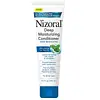What's inside
What's inside
 Key Ingredients
Key Ingredients

No key ingredients
 Benefits
Benefits

 Concerns
Concerns

 Ingredients Side-by-side
Ingredients Side-by-side

Water
Skin ConditioningCetearyl Alcohol
EmollientBehentrimonium Chloride
PreservativeCeteareth-20
CleansingCetrimonium Chloride
AntimicrobialCaprylic/Capric Triglyceride
MaskingDimethicone
EmollientGlycerin
HumectantLinoleamidopropyl Pg-Dimonium Chloride Phosphate
Butyrospermum Parkii Butter
Skin ConditioningSimmondsia Chinensis Seed Oil
EmollientPanthenol
Skin ConditioningAllantoin
Skin ConditioningArginine
MaskingPolysorbate 80
EmulsifyingTocopherol
AntioxidantMentha Piperita Oil
MaskingMenthol
MaskingCamellia Sinensis Leaf Extract
AntimicrobialAscorbic Acid
AntioxidantMelaleuca Alternifolia Leaf Oil
AntioxidantXanthan Gum
EmulsifyingPhenoxyethanol
PreservativeDisodium EDTA
Potassium Sorbate
PreservativeCitric Acid
BufferingWater, Cetearyl Alcohol, Behentrimonium Chloride, Ceteareth-20, Cetrimonium Chloride, Caprylic/Capric Triglyceride, Dimethicone, Glycerin, Linoleamidopropyl Pg-Dimonium Chloride Phosphate, Butyrospermum Parkii Butter, Simmondsia Chinensis Seed Oil, Panthenol, Allantoin, Arginine, Polysorbate 80, Tocopherol, Mentha Piperita Oil, Menthol, Camellia Sinensis Leaf Extract, Ascorbic Acid, Melaleuca Alternifolia Leaf Oil, Xanthan Gum, Phenoxyethanol, Disodium EDTA, Potassium Sorbate, Citric Acid
Ingredients Explained
These ingredients are found in both products.
Ingredients higher up in an ingredient list are typically present in a larger amount.
Citric Acid is an alpha hydroxy acid (AHA) naturally found in citrus fruits like oranges, lemons, and limes.
Like other AHAs, citric acid can exfoliate skin by breaking down the bonds that hold dead skin cells together. This helps reveal smoother and brighter skin underneath.
However, this exfoliating effect only happens at high concentrations (20%) which can be hard to find in cosmetic products.
Due to this, citric acid is usually included in small amounts as a pH adjuster. This helps keep products slightly more acidic and compatible with skin's natural pH.
In skincare formulas, citric acid can:
While it can provide some skin benefits, research shows lactic acid and glycolic acid are generally more effective and less irritating exfoliants.
Most citric acid used in skincare today is made by fermenting sugars (usually from molasses). This synthetic version is identical to the natural citrus form but easier to stabilize and use in formulations.
Read more about some other popular AHA's here:
Learn more about Citric AcidDimethicone is a type of synthetic silicone created from natural materials such as quartz.
What it does:
Dimethicone comes in different viscosities:
Depending on the viscosity, dimethicone has different properties.
Ingredients lists don't always show which type is used, so we recommend reaching out to the brand if you have questions about the viscosity.
This ingredient is unlikely to cause irritation because it does not get absorbed into skin. However, people with silicone allergies should be careful about using this ingredient.
Note: Dimethicone may contribute to pilling. This is because it is not oil or water soluble, so pilling may occur when layered with products. When mixed with heavy oils in a formula, the outcome is also quite greasy.
Learn more about DimethiconePhenoxyethanol is a preservative that has germicide, antimicrobial, and aromatic properties. Studies show that phenoxyethanol can prevent microbial growth. By itself, it has a scent that is similar to that of a rose.
It's often used in formulations along with Caprylyl Glycol to preserve the shelf life of products.
Water. It's the most common cosmetic ingredient of all. You'll usually see it at the top of ingredient lists, meaning that it makes up the largest part of the product.
So why is it so popular? Water most often acts as a solvent - this means that it helps dissolve other ingredients into the formulation.
You'll also recognize water as that liquid we all need to stay alive. If you see this, drink a glass of water. Stay hydrated!
Learn more about Water